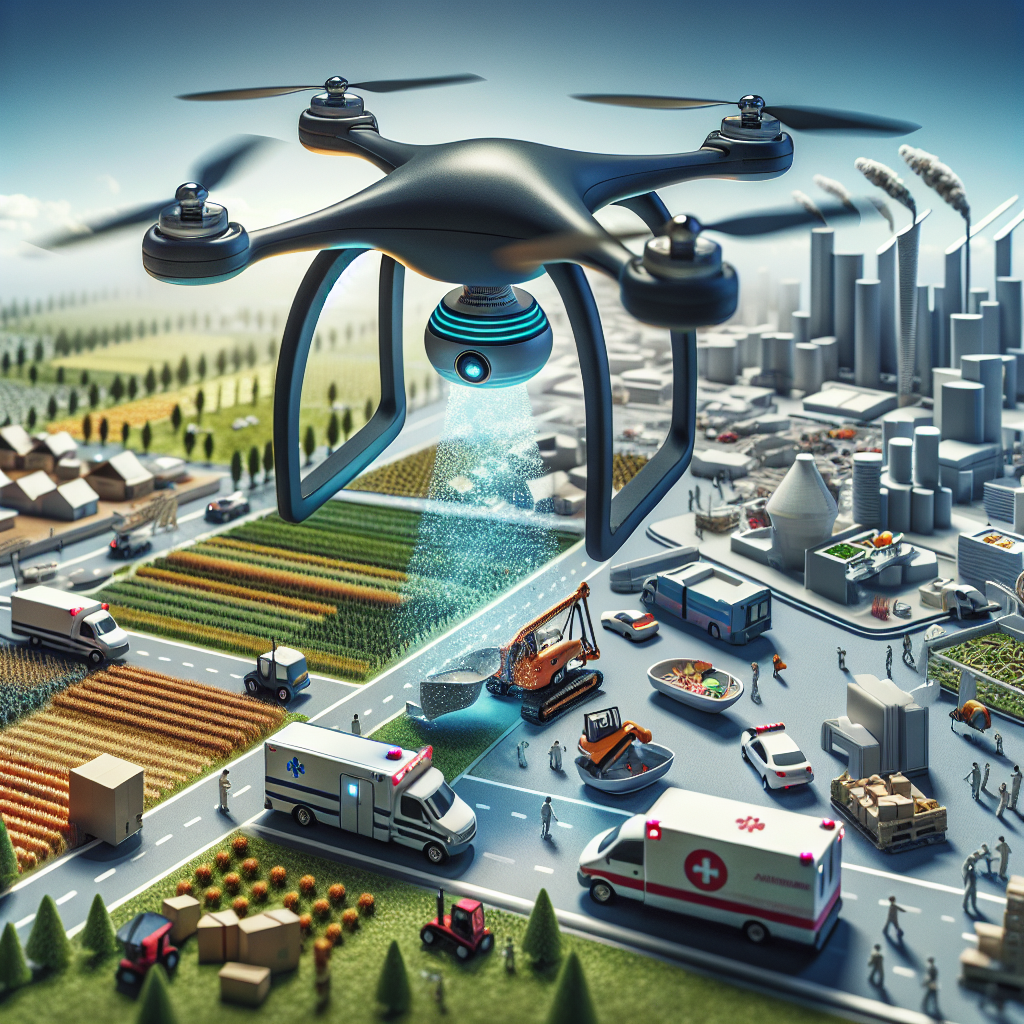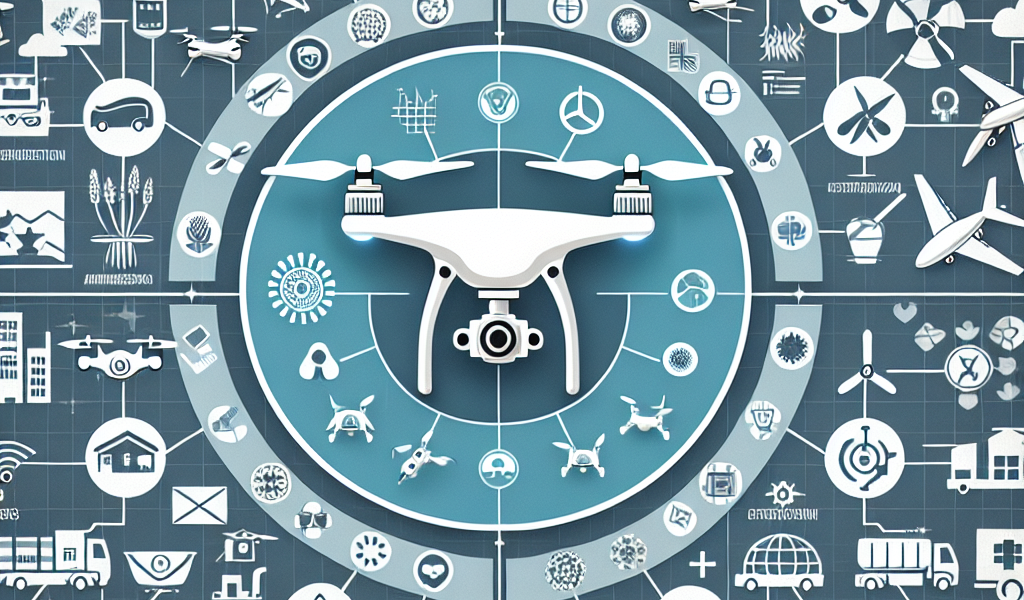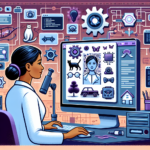-
Table of Contents
“Revolutionizing Industries: The Autonomous Drone Advantage”
Introduction

The advent of autonomous drones has revolutionized numerous industries, heralding a new era of efficiency, precision, and innovation. These unmanned aerial vehicles, equipped with advanced sensors, artificial intelligence, and machine learning capabilities, are transforming sectors such as agriculture, logistics, surveillance, and environmental monitoring. In agriculture, drones enable precision farming by providing real-time data on crop health, soil conditions, and pest infestations, thereby optimizing yields and reducing resource usage. In logistics, they offer rapid, cost-effective delivery solutions, particularly in remote or congested areas. Surveillance and security industries benefit from enhanced monitoring capabilities, while environmental monitoring is significantly improved through the collection of critical data on climate change, wildlife, and natural disasters. As autonomous drone technology continues to evolve, its impact on these and other industries is expected to grow, driving further advancements and reshaping traditional practices.
Revolutionizing Agriculture: The Role of Autonomous Drones in Modern Farming
In recent years, the agricultural sector has witnessed a technological revolution, with autonomous drones emerging as a game-changer. These high-tech devices are transforming traditional farming practices, offering a range of benefits that enhance efficiency, productivity, and sustainability. As farmers face increasing pressure to meet the demands of a growing global population, autonomous drones are proving to be invaluable tools in modern farming.
One of the most significant advantages of autonomous drones in agriculture is their ability to perform precise and timely crop monitoring. Equipped with advanced sensors and imaging technology, these drones can capture high-resolution images and gather data on crop health, soil conditions, and pest infestations. This real-time information allows farmers to make informed decisions, optimizing the use of resources such as water, fertilizers, and pesticides. Consequently, this leads to healthier crops, higher yields, and reduced environmental impact.
Moreover, autonomous drones are revolutionizing the way farmers manage their fields. Traditional methods of field surveying and mapping are often time-consuming and labor-intensive. In contrast, drones can cover large areas quickly and accurately, creating detailed maps that highlight variations in soil quality and crop performance. This enables farmers to implement precision agriculture techniques, where inputs are applied only where needed, minimizing waste and maximizing efficiency. The result is a more sustainable approach to farming that conserves resources and reduces costs.
In addition to monitoring and mapping, autonomous drones are also being used for planting and seeding. Some drones are equipped with specialized systems that can disperse seeds evenly across a field, ensuring optimal plant density and reducing the need for manual labor. This is particularly beneficial for reforestation projects and the restoration of degraded lands, where drones can access hard-to-reach areas and plant seeds with precision. By automating these tasks, farmers can save time and effort, allowing them to focus on other critical aspects of farm management.
Furthermore, autonomous drones are playing a crucial role in crop spraying and pest control. Traditional methods of applying pesticides and fertilizers often involve the use of large machinery, which can be inefficient and harmful to the environment. Drones, on the other hand, can deliver these substances with pinpoint accuracy, targeting specific areas that require treatment. This not only reduces the amount of chemicals used but also minimizes the risk of contamination to surrounding ecosystems. Additionally, drones can operate in challenging weather conditions and difficult terrains, ensuring that crops receive the necessary care regardless of external factors.
The integration of autonomous drones into modern farming practices is also fostering innovation and collaboration within the agricultural industry. Tech companies, research institutions, and farmers are working together to develop new drone technologies and applications. This collaborative effort is driving advancements in artificial intelligence, machine learning, and data analytics, further enhancing the capabilities of autonomous drones. As a result, farmers are gaining access to cutting-edge tools that empower them to make smarter decisions and improve overall farm management.
In conclusion, the impact of autonomous drones on agriculture is profound and far-reaching. By providing precise crop monitoring, efficient field management, automated planting, and targeted crop spraying, these drones are revolutionizing the way farmers operate. As technology continues to evolve, the role of autonomous drones in modern farming is set to expand, offering even greater benefits to the agricultural sector. Embracing this technological innovation is essential for farmers who seek to enhance productivity, sustainability, and resilience in an ever-changing world.
Enhancing Public Safety: How Autonomous Drones Are Transforming Emergency Response
Autonomous drones are revolutionizing the way emergency response teams operate, offering unprecedented capabilities that enhance public safety. These high-tech devices, equipped with advanced sensors and artificial intelligence, are becoming indispensable tools in various emergency scenarios. As they continue to evolve, their impact on public safety is becoming increasingly evident, transforming how first responders approach critical situations.
One of the most significant advantages of autonomous drones is their ability to quickly reach areas that are difficult or dangerous for humans to access. In the aftermath of natural disasters such as earthquakes, floods, or hurricanes, these drones can be deployed to survey the affected regions, providing real-time data and high-resolution imagery. This immediate access to information allows emergency teams to assess the extent of the damage, identify areas in need of urgent assistance, and allocate resources more effectively. Consequently, the speed and efficiency of disaster response are greatly improved, potentially saving countless lives.
Moreover, autonomous drones are proving to be invaluable in search and rescue operations. Equipped with thermal imaging cameras and other advanced sensors, these drones can detect heat signatures from people trapped under rubble or lost in remote areas. By autonomously scanning large areas and pinpointing the exact locations of individuals in distress, drones significantly reduce the time it takes for rescue teams to reach and assist them. This capability is particularly crucial in situations where every second counts, such as avalanches or building collapses.
In addition to natural disasters and search and rescue missions, autonomous drones are also enhancing public safety in urban environments. Law enforcement agencies are increasingly utilizing these devices for surveillance and monitoring purposes. For instance, during large public events or protests, drones can provide a bird’s-eye view of the crowd, helping authorities to manage the situation more effectively and respond swiftly to any incidents. This aerial perspective not only improves situational awareness but also minimizes the risk to officers on the ground.
Furthermore, autonomous drones are being integrated into firefighting operations, offering a new dimension of support to firefighters. In the event of a large-scale fire, drones can be deployed to assess the spread and intensity of the flames, identify hotspots, and monitor the structural integrity of buildings. This information is crucial for firefighters to strategize their approach and ensure their safety while combating the blaze. Additionally, drones equipped with water or fire retardant payloads can directly assist in extinguishing fires, particularly in hard-to-reach areas.
The use of autonomous drones in emergency medical services is another area where their impact is becoming increasingly apparent. Drones can be used to deliver medical supplies, such as defibrillators, blood, or medications, to remote or inaccessible locations. In situations where traditional means of transportation are hindered by traffic or terrain, drones offer a rapid and reliable alternative. This capability can be life-saving, especially in rural areas or during large-scale emergencies where medical resources are stretched thin.
As technology continues to advance, the potential applications of autonomous drones in enhancing public safety are bound to expand. However, it is essential to address the challenges associated with their deployment, such as regulatory hurdles, privacy concerns, and the need for robust cybersecurity measures. By navigating these challenges and harnessing the full potential of autonomous drones, emergency response teams can continue to improve their effectiveness and efficiency, ultimately making our communities safer.
In conclusion, autonomous drones are transforming emergency response across various scenarios, from natural disasters and search and rescue missions to urban surveillance and firefighting. Their ability to provide real-time data, reach inaccessible areas, and support first responders is revolutionizing public safety, offering new hope and possibilities in critical situations. As we continue to explore and refine this technology, the future of emergency response looks brighter than ever.
Redefining Logistics: The Future of Delivery Services with Autonomous Drones
The advent of autonomous drones is poised to revolutionize the logistics industry, promising to redefine delivery services in ways that were once the stuff of science fiction. As these flying robots become more sophisticated, their potential applications are expanding, offering a glimpse into a future where the efficiency and speed of deliveries could be dramatically enhanced. This transformation is not just a technological marvel but a significant shift that could impact various sectors, from retail to healthcare.
To begin with, the retail industry stands to benefit immensely from the integration of autonomous drones into its logistics framework. E-commerce giants like Amazon and Walmart have already started experimenting with drone deliveries, aiming to reduce the time it takes for products to reach consumers. Imagine ordering a product online and having it delivered to your doorstep within hours, bypassing the traditional delays associated with ground transportation. This rapid delivery service could not only improve customer satisfaction but also reduce the carbon footprint associated with conventional delivery trucks.
Moreover, the healthcare sector is another area where autonomous drones could make a substantial impact. In remote or hard-to-reach locations, drones can be used to deliver essential medical supplies, such as vaccines, blood samples, and even organs for transplant. This capability could be life-saving in emergency situations where time is of the essence. For instance, during the COVID-19 pandemic, drones were employed in some regions to transport test samples and medical supplies, showcasing their potential to support healthcare logistics in critical times.
Transitioning to the food and beverage industry, autonomous drones are also making waves. Companies like Uber Eats and Domino’s have been exploring the use of drones to deliver food orders, aiming to provide faster and more efficient service. This innovation could revolutionize the food delivery landscape, offering a novel solution to urban congestion and reducing the reliance on traditional delivery methods. As a result, customers could enjoy fresher meals delivered in a fraction of the time it currently takes.
In addition to these sectors, the agricultural industry is also set to benefit from the deployment of autonomous drones. Farmers can use drones for a variety of tasks, such as monitoring crop health, spraying pesticides, and even planting seeds. These applications not only enhance productivity but also reduce the need for manual labor, allowing farmers to focus on other critical aspects of their operations. The precision and efficiency offered by drones can lead to better crop yields and more sustainable farming practices.
While the potential benefits of autonomous drones are vast, it is important to consider the challenges and regulatory hurdles that come with their widespread adoption. Issues such as airspace management, privacy concerns, and the need for robust cybersecurity measures must be addressed to ensure the safe and effective integration of drones into the logistics ecosystem. Governments and regulatory bodies around the world are working on frameworks to manage these challenges, aiming to strike a balance between innovation and safety.
In conclusion, the impact of autonomous drones on various industries is undeniable, with the potential to transform logistics and delivery services in unprecedented ways. From retail and healthcare to food delivery and agriculture, these flying robots offer a glimpse into a future where efficiency, speed, and sustainability are at the forefront of logistics operations. As technology continues to advance and regulatory frameworks evolve, the widespread adoption of autonomous drones could become a reality, ushering in a new era of delivery services that redefine the way we receive goods and services.
Conclusion
The impact of autonomous drones on various industries is profound and multifaceted. In agriculture, they enhance precision farming by providing real-time data on crop health, soil conditions, and pest infestations, leading to increased yields and reduced resource usage. In logistics and delivery, drones offer faster, more efficient, and cost-effective solutions for transporting goods, particularly in remote or congested areas. The construction industry benefits from improved site surveys, monitoring, and safety inspections, resulting in better project management and reduced risks. In the energy sector, drones facilitate the inspection and maintenance of infrastructure such as power lines and wind turbines, minimizing downtime and enhancing safety. Additionally, in emergency response and disaster management, drones provide critical support through rapid assessment, search and rescue operations, and delivery of essential supplies. Overall, autonomous drones are revolutionizing these industries by improving efficiency, reducing costs, and enhancing safety, thereby driving significant advancements and transforming traditional operational paradigms.




